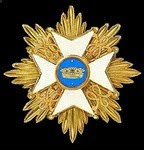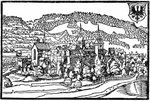Captain John Stevens records in his Journal that Oliver, Lord Louth's regiment in June 1690 consisted of 13 companies, each of 62 men for a total of 806 private soldiers at full strength. He describes the brown on the flags as "filamot", obviously a distortion of the French feuille morte or "dead leaf". Their uniform was white lined and faced filamot, clearly a popular colour with some Jacobites.
The flags are a little sombre but have their own quiet appeal. As I am sure I have said before, not all flags can be wildly colourful!

According to this webpage: https://www.louthnewryarchives.ie/online-exhibitions/landowners-county-louth/louth.shtml "Matthew, the 7th Baron Louth, joined the Jacobite cause in 1689 and
commanded an infantry regiment at the seige of Derry. He was outlawed
and exiled, and died in September 1689. The 8th Baron Louth, Oliver, was only 21 when he succeeded to the title
in 1689. He joined the Jacobite forces and was outlawed, and was in
Limerick at the surrender in 1691."
Louth's, Bellew's and Slane's regiments are discussed in "Louth Regiments in the Irish Jacobite Army" by Diarmuid Murtagh in Journal of the County Louth Archaeological Society, 1953, Vol. 13, No. 1 (1953), pp. 8-15:
"There is an early report upon Louth's and Bellew's which is of passing interest. Writing from Dungannon under date 6th April, 1689, Major-General Pusignan reports : "I have seen the regiments of Bellew, of Gormanstown and of Louth, which have not got a single sword, and not enough muskets. The companies are stronger in pikes than in muskets, and of these very few of what there are are capable of being fired." Despite this lack of equipment, Pusignan led them both north to join the besieging army before Derry."
A return for the three regiments of 27th September, 1689 suggests that by then the regiments had acquired many more muskets but that only Bellew's had pikes, and "we find Slane's with the very unusual equipment of 100% muskets. This contained the germ of disaster, as the Huguenots were to find at the Boyne, for in the days before bayonets, a proportion of pikes or their equivalent was essential to protect the battalion from the charge of cavalry."
Bellew and Louth's regiments were part of the front line during the Boyne campaign and, along with Slane's, fell back on Limerick after the battle and formed part of the garrison. All three regiments took part in the campaign of 1691 and fought at Aughrim, where they suffered heavy casualties. Lord Slane was taken prisoner and Lord Bellew mortally wounded, lingering to die in the following January, with what suffering can perhaps be imagined. On his monument in Duleek church his widow Lady Margaret recorded that he "was shot in the belly at Aughrim fight".
















































